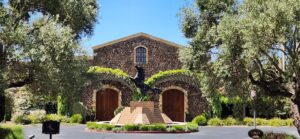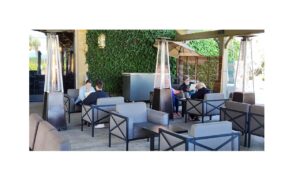There are a number of reasons to enjoy a wine tasting visit to Stags’ Leap Winery (https://www.stagsleap.com/): history, architecture, vistas, beauty and of course the wines. The tasting “room” is actually a house, more of a mansion that has been lovingly restored to its condition around the turn of the previous century. It has been the home of rich people, a resort hotel, a speakeasy, a home to squatters and, finally, a commercial winery.
You learn all the details and get to see much of the building as a part of what they call a Manor House Experience. You can also taste the wines without the tour, but we highly recommend being shown around. As you enter the property, you pass through an arcade of trees and see vineyards that date to the 1880’s. You climb a hill to the parking lot and view across the estate, with more vineyards below. You will notice magnificent gardens everywhere around you and then you’ll see this Victorian mansion, made of stone with a grand veranda running along one side.
 When you step inside, the room you enter is resplendent of early 20th century design, somewhere between Gatsby and your (rich) grandmother. The chandelier made of stags’ horns certainly catches the eye, as do all the burnished wood accoutrements. You don’t have to whisper, but you do feel as though you ought to.
When you step inside, the room you enter is resplendent of early 20th century design, somewhere between Gatsby and your (rich) grandmother. The chandelier made of stags’ horns certainly catches the eye, as do all the burnished wood accoutrements. You don’t have to whisper, but you do feel as though you ought to.
A tour guide takes you through the house, outbuildings and gardens, offering tastings of Stags’ Leaps’ lighter wines as you go. You wind up in an equally impressive dining room with the crest of the winery in stained glass. Here you sit and are served their more well-known wines. Since this is Napa Valley they serve a Cabernet Sauvignon, but interestingly, this is not Stag Leaps’ flagship wine. They are best known for Petite Sirah, both in the more widely known white label with a leaping stag and their black label premium bottling. It is the latter, more interesting wine that they serve on the tour.
The overall impression you get from a visit to Stags’ Leap is of old-money luxury. In fact you learn during the tour that there was once a lot of money but it ran out and was only restored to its former glory in the 1980’s. It has been kept up by the current owner, Treasury Wine Cellars. What you see is gracious, as are the guides, and the wines project a full-bodied savor that may not be quite as fashionable as it once was but echoes what Napa Valley has always been. In fact, that may be said about the visit as a whole.
We cannot fail to relate the history of the apostrophe. The AVA is Stags Leap, with no apostrophe at all. It merely says that stags do leap. Down the road is Stag’s Leap Wine Cellars (a leap by one stag). This winery is Stags’ Leap (the leap of many stags). Is that clear? Actually, no it isn’t and it was the subject of lawsuits for quite a few years. The guide tells the story with a little chuckle, but it’s clear that there are still some bruises felt after all this time.

















